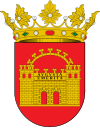Mérida (Spain)
| Merida | ||
|---|---|---|

|
||
| coat of arms | Map of Spain | |

|
|
|
| Basic data | ||
| Autonomous Community : |
|
|
| Province : | Badajoz | |
| Comarca : | Tierra de Mérida - Vegas Bajas | |
| Coordinates | 38 ° 55 ′ N , 6 ° 21 ′ W | |
| Height : | 290 msnm | |
| Area : | 865.6 km² | |
| Residents : | 59,335 (Jan 1, 2019) | |
| Population density : | 68.55 inhabitants / km² | |
| Founding: | 25 BC Chr. | |
| Postal code : | 06800 | |
| Municipality number ( INE ): | 06083 | |
| administration | ||
| Mayor : | Pedro Acedo Penco ( PP , 2011) | |
| Website : | www.merida.es | |
| Location of the city | ||

|
||
Mérida [ ˈmeɾiða ] is the capital of the Autonomous Region of Extremadura in southwest Spain . The city belongs to the province of Badajoz and has about 59,335 inhabitants (as of January 1, 2019).
location
The city is located in southwest Spain in the middle of Extremadura in the Guadiana Valley , south of Cáceres , west of Don Benito and north of Zafra (Tierra de Barros). To the west in the same valley are Montijo and Badajoz . The Albarregas flows here from the northeast . After Madrid (northeast) there are about 340 km away. The height above the sea is 217 m.
history
Antiquity
In the Roman Empire , the city was the capital of the province of Lusitania under the name Emerita Augusta . It was born in 25 BC. Founded by Emperor Augustus as a colony for veterans of Roman legions . Numerous representative buildings were erected over the years: theaters , amphitheaters , circuses , temples , bridges and aqueducts . For centuries, until the fall of the Roman Empire, Mérida was an important economic, military and cultural center.
middle Ages
Mérida later had to withstand several invasions by the Vandals until the Visigoths made it the capital of their kingdom. In the 6th and 7th centuries, an area that included almost all of today's Spain and Portugal was ruled from Mérida.
In the 6th century Christianity spread strongly among the population - the Bishop Mausona in particular contributed to this. For example, the martyr Santa Eulalia , the patron saint of the city, comes from the popular beliefs of this time .
In 713 the Arabs under Musa ibn Nusair conquered the city and ravaged it. Even under Islamic rule, Mérida remained the bishopric until it was moved to Santiago de Compostela in 1119 .
In 1230 the Christian troops under Alfonso IX conquered . of León Mérida in the course of the Reconquista .
Modern times
In the 20th century, Mérida became a railway hub and center of industry . In addition, the international archeology interest in the numerous preserved ancient buildings in the city increased. During the Spanish Civil War , Republican forces tried to stop the advance of the nationalists in front of Mérida during the Battle of Mérida .
After the democratization of Spain in the 1970s, it was decided to make the city the capital of the Autonomous Region of Extremadura, given its historical importance and its central location.
The archaeological sites, including the Lácara dolmen , were added to the UNESCO World Heritage List in December 1993 .
| year | 1991 | 1996 | 2001 | 2006 |
|---|---|---|---|---|
| Residents | 49.284 | 51,830 | 50.271 | 53,915 |
Culture
An annual cultural festival has been held in the Roman Theater every summer since 1933.
Attractions
The monuments from Roman times include:
- El Puente Romano ("The Roman Bridge") over the Guadiana River, which wasin useuntil the 1990s
- Roman bridge over the Albarregas river
- the temple of Diana
- the remains of the forum including the Arch of Trajan ( Arch of Trajan )
- the remains of the Circus Maximus (horse racing track)
- the Acueducto de los Milagros ( aqueduct )
- the Acueducto de Rabo de Buey-San Lázaro (Oxtail St. Lazarus)
- the Proserpina dam
- the Mithraeum (Temple of the Mithraic cult )
- the Roman Theater, where classical plays are still performed at the summer festival .
- the amphitheater
- the Roman Museum, with beautiful mosaics, a coin collection and building remains from Roman times
- Approx. 100 km to the north is the Alcántara Bridge , a bridge co-financed by Mérida that connected the city and Lusitania to the northwest of the Iberian Peninsula.
sons and daughters of the town
- Josef ibn Abitur (around 900 – around 970), rabbi, Jewish scholar and one of the first Jewish poets in Spain
- Juan Antonio Guerrero Alves (* 1959), Roman Catholic clergyman and curia official
- Víctor Manuel Fernández Gutiérrez (* 1974), football player
- Carolina Fernández (born in the late 1980s), flamenco singer
Individual evidence
- ↑ Cifras oficiales de población resultantes de la revisión del Padrón municipal a 1 de enero . Population statistics from the Instituto Nacional de Estadística (population update).
Web links
- Official website of Mérida (Spanish)
- Museum guide of the city of Mérida (German)



